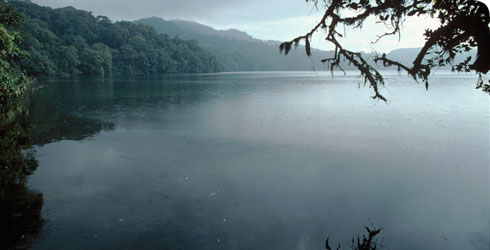Conservation
Isoetes biafrana has been assessed as Vulnerable (Cheek et al. 2000) because only a small fraction of the original rain forest still exists around Lake Oku in Cameroon and this is threatened by increased grazing by goats in the lake's crater, which increases soil erosion around the lake and may cover the gravel bottom, preventing Isoetes biafranum from becoming established since it does not root in mud-bottomed lakes.
Grazing of livestock and forest clearance need to be stopped, and a thorough survey of population sizes of Isoetes biafranum should be undertaken around the perimeter of the lake.
Several hundred plants were recorded in Lake Oku, below the Baptist Rest House, in November 1996, but there is no record of the number of individuals found in Lake Moka on Bioko. Due to its very restricted range and number of locations, and the threats known to occur in the range of Isoetes biafrana, this species has been assigned the category of Vulnerable under criterion D2.
